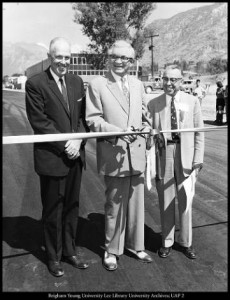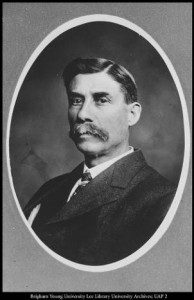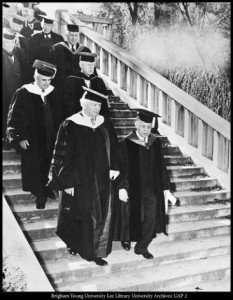
Ever wonder where some buildings on campus got their names? Most of us know who the George Albert Smith Fieldhouse, the Joseph Smith Building and the Gordon B. Hinckley Alumni and Visitors Center were named after, but what about the Roland A. Crabtree building or the W.W. Clyde Building?
Pick up The Universe every day this week for a look into how some BYU buildings got their names.
Sam F. Brewster Building:
Named after Sam F. Brewster, a close friend of former BYU president Ernest L. Wilkinson, to honor him as one of BYU’s former directors of planning, construction and maintenance. Many of the buildings on campus were planned and built during Brewster’s time as director.
Dedicated: 1962
The Brewster building currently houses the BYU Physical Facilities administrative offices, key office, carpenter shop, paint shop, mechanical shop, heating/air conditioning shop, electrical shop and motor pool facilities, as well as storage for lumber, custodial and maintenance equipment.
George H. Brimhall Building:
Named after George H. Brimhall (Dec. 9, 1852 – July 29, 1932), who was the President of BYU from 1903-1921.
Dedicated: 1918
In its early years, the building was used by the Student Army Training Corps during World War I. It later housed the Department of Mechanical Arts, where

blacksmithing and woodworking classes were taught. At one point, the building even served as the garage for the university president’s car. In 1933, classrooms in the building held some of the first journalism courses, many of which are still taught today. The building currently houses the Department of Communications and student-run news organizations The Universe, 11News, the Bradley PR lab and an advertising lab.
W.W. Clyde Building:
Bamed after W. W. Clyde of Springville, who was a successful contractor and generous contributor to BYU.
Dedicated: 1974
The Clyde Building houses the College of Engineering and Technology. Engineering students prize its large study rooms, but more than 40 percent of the total floor space is used for laboratory instruction and research in electrical, chemical, civil and mechanical engineering, as well as for engineering analysis and interdepartmental functions. Transistors can be made from scratch in the solid-state laboratory. Facilities are also available for environmental, high-pressure, saline water, thermodynamics, nuclear and transport processes research.
Stephen L. Richards Building:

Named after Stephen L. Richards (June 18, 1879 – May 19, 1959), who was an apostle for The Church of Jesus Christ of Latter-day Saints. Joseph F. Smith called Richards to be an apostle at the age of 37.
Richards became a member of the Superintendency of the Deseret Sunday School Union under David O. McKay in 1918. In April 1919, McKay was appointed Church Commissioner of Education and chose Richards as his first counselor. Richards remained a counselor in the Deseret Sunday School Union Superintendency until 1934, when apostles were released from these positions and men were called who could devote their full time to the Sunday school, also freeing up the apostles to focus more on their specific callings. When McKay became president of the Church, he selected Richards as his first counselor. Richards served in that position from April 9, 1951, until his death in 1959.
Dedicated: 1965
The Richards Building (also known around campus as the “RB”) is an athletics building that includes sports courts and three Olympic-sized swimming pools. An addition to the north end of the building, including additional dance practice rooms was completed in 2008.




